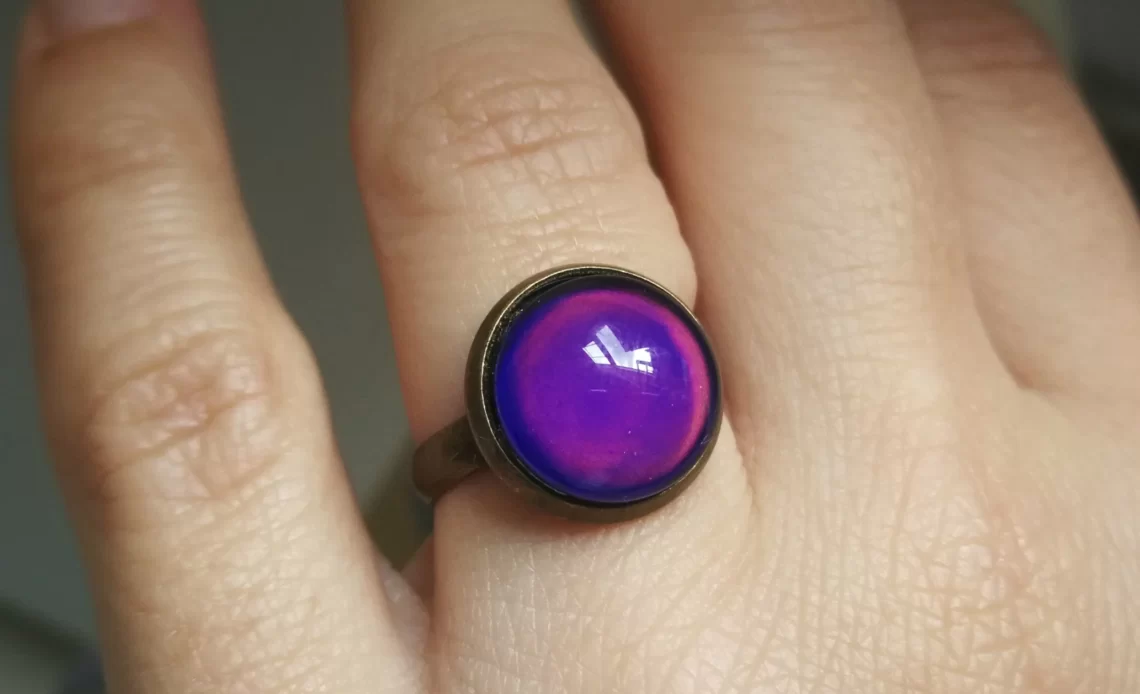
Mood rings have been around since the 1970s and have been popular ever since. They are a type of fashion accessory that is believed to change color based on the wearer’s emotional state. While they may not be the most scientifically accurate way to determine your mood, mood ring color meanings can still provide insight into your emotional state. In this article, we will explore the history of mood rings, how they work, and the meaning behind each color.
Firstly, the colors of the mood ring change based on the temperature of your finger, which in turn reflects your mood. Black color on a mood ring signifies stress or negativity, blue represents a relaxed and calm state, green means you’re feeling happy and content, while yellow reflects mixed emotions or excitement. If you see purple on your ring, it means you’re feeling passionate, and red represents strong emotions like anger or love.
But these color meanings can be interpreted differently by different people, and there’s more to it than just the colors. In this article, we will dive deeper into the psychology of mood rings and the meanings behind each color. We’ll also explore the history of mood rings and how they became popular. So, are you ready to uncover the mysteries of mood ring color meanings? Let’s get started!
The History of Mood Rings
The concept of mood rings can be traced back to ancient civilizations, who believed that gemstones and other materials had mystical powers that could affect a person’s emotions. The modern mood ring, however, was invented by a jeweler named Marvin Wernick in the 1970s. Wernick created a ring that contained a thermochromic element, which changed color based on the wearer’s body temperature. The first mood rings were a sensation and quickly became a popular fashion accessory.
How Mood Rings Work
Mood rings contain a liquid crystal that is sensitive to changes in temperature. When the temperature of the crystal changes, it causes the molecules to shift, which alters the color of the ring. The liquid crystal in a mood ring is typically made from a combination of organic materials, such as cholesterol, which can change color in response to temperature changes. The ring may also contain a metal strip that acts as a thermometer and helps to determine the temperature of the wearer’s skin.
Thermochromism
The secret to mood rings lies in a process called thermochromism. Thermochromic materials are substances that change color in response to changes in temperature. In the case of mood rings, the material used is typically a liquid crystal.
The liquid crystal in a mood ring is made up of molecules that are sensitive to temperature. When the temperature changes, the molecules in the liquid crystal move around, causing the crystal to change color. This change in color can be seen on the surface of the ring, making it easy to see how the wearer’s mood is changing.
We explain how mood rings work in more detail in the linked article.
Interpreting the Mood Ring Colors
Of course, knowing how mood rings work is only half the battle. To really understand what your mood ring is telling you, you need to know how to interpret the colors.
Black or dark gray typically indicates feelings of stress or anxiety. Blue is associated with calmness and relaxation. Green usually means the wearer is feeling balanced and at ease. Yellow can indicate excitement or nervousness. Orange is often associated with creativity and inspiration. Red is a sign of passion, love, or anger. Finally, purple often means the wearer is feeling introspective or reflective.
It’s important to remember that mood rings are not an exact science. Everyone experiences emotions differently, so the same color on a mood ring can mean different things to different people. Additionally, outside factors like temperature and lighting can affect the color of the ring, making it less accurate.
Mood Ring Color Meanings
The color of a mood ring can indicate the wearer’s emotional state. While there is no standard set of color meanings, here are some common interpretations:
| Mood Ring Color | Mood Ring Color Meaning |
|---|---|
| Blue | Calm, relaxed, peaceful |
| Green | Balanced, stable, harmonious |
| Yellow | Nervous, anxious, excited |
| Orange | Stressed, tense, overwhelmed |
| Red | Angry, agitated, passionate |
| Black | Stressed, tense, overworked |
| Purple | Happy, romantic, passionate |
| Pink | Love, affection, happiness |
| Brown | Anxious, restless, uncomfortable |
| Gray | Sad, depressed, stressed |
Blue
Blue is often associated with feelings of calmness and relaxation. If your mood ring is blue, it may indicate that you are feeling calm, relaxed, and at peace. Blue is also associated with spirituality and intuition.
Green
Green is associated with balance and harmony. If your mood ring is green, it may indicate that you are feeling balanced, harmonious, and grounded. Green is also associated with growth and abundance.
Yellow
Yellow is associated with happiness and joy. If your mood ring is yellow, it may indicate that you are feeling happy, joyful, and optimistic. Yellow is also associated with intellect and creativity.
Brown
Brown is associated with stability and security. If your mood ring is brown, it may indicate that you are feeling stable, secure, and grounded. Brown is also associated with earthiness and practicality.
Black
The color black is often associated with negative emotions, such as fear and sadness. If your mood ring is black, it may indicate that you are feeling anxious, stressed, or sad. Black is also associated with
negativity and mystery.
Gray
Gray is associated with neutrality and balance. If your mood ring is gray, it may indicate that you are feeling neutral or uncertain. Gray is also associated with practicality and wisdom.
Purple
Purple is associated with creativity and imagination. If your mood ring is purple, it may indicate that you are feeling creative, imaginative, and inspired. Purple is also associated with spirituality and higher consciousness.
Pink
Pink is associated with love and affection. If your mood ring is pink, it may indicate that you are feeling loving, caring, and affectionate. Pink is also associated with nurturing and femininity.
Red
Red is associated with passion and intensity. If your mood ring is red, it may indicate that you are feeling passionate, intense, and energetic. Red is also associated with love and desire.
Orange
Orange is associated with enthusiasm and excitement. If your mood ring is orange, it may indicate that you are feeling enthusiastic, excited, and adventurous. Orange is also associated with warmth and joy.
It’s important to note that the color of a mood ring can vary depending on a number of factors, such as the wearer’s body temperature, the temperature of their surroundings, and the quality of the ring itself. Additionally, different cultures and individuals may interpret the colors differently.
What if My Mood Ring is Constantly Changing Colors?
If your mood ring is constantly changing colors, it may be a sign that it’s not functioning properly. In some cases, the liquid crystal may be damaged or the metal strip may be broken. If you suspect that your mood ring is not working correctly, it’s best to replace it or have it repaired.
Can Mood Rings Actually Predict Your Mood?
While mood rings can provide insight into your emotional state, they are not a reliable or accurate way to predict your mood. The color of a mood ring is determined by changes in temperature, which can be influenced by a number of factors beyond your emotional state. Therefore, it’s important to use caution when interpreting the meaning of a mood ring’s color.
The Benefits of Wearing a Mood Ring
While mood rings may not be scientifically accurate, they can still provide some benefits. Wearing a mood ring can serve as a reminder to check in with your emotional state and practice self-awareness. Additionally, mood rings can be a fun and unique way to express your personality and style.
Caring for Your Mood Ring
To ensure that your mood ring lasts as long as possible, it’s important to care for it properly. Avoid exposing your ring to extreme temperatures, as this can damage the liquid crystal. Additionally, avoid exposing your ring to water, as this can cause it to rust or tarnish. Finally, store your mood ring in a cool, dry place when you’re not wearing it.
Conclusion
Mood rings are a fun and unique way to express your emotions and style. While the colors of a mood ring may not be a reliable indicator of your emotional state, they can still provide insight into your mood. Whether you’re wearing a mood ring for fun or for its potential benefits, it’s important to understand the meaning behind each color and care for your ring properly.
FAQs
Are mood rings accurate?
Mood rings are not scientifically accurate, as they are not able to accurately predict a person’s mood. However, they can provide insight into a person’s emotional state.
How do mood rings work?
Mood rings contain a liquid crystal that is sensitive to changes in temperature. When the temperature of the crystal changes, it causes the molecules to shift, which alters the color of the ring.
Can I wear my mood ring in the shower?
It’s best to avoid exposing your mood ring to water, as this can cause it to rust or tarnish. It’s recommended to remove your mood ring before showering, swimming, or engaging in any water-related activities.
What if my mood ring constantly changes colors?
If your mood ring is constantly changing colors, it may be a sign that it’s not functioning properly. In this case, it’s best to replace it or have it repaired.
Can mood rings be used as a therapeutic tool?
While mood rings are not a scientifically proven therapeutic tool, they can still serve as a reminder to check in with your emotional state and practice self-awareness. Some people may find wearing a mood ring helpful in managing their emotions and maintaining a positive outlook.

